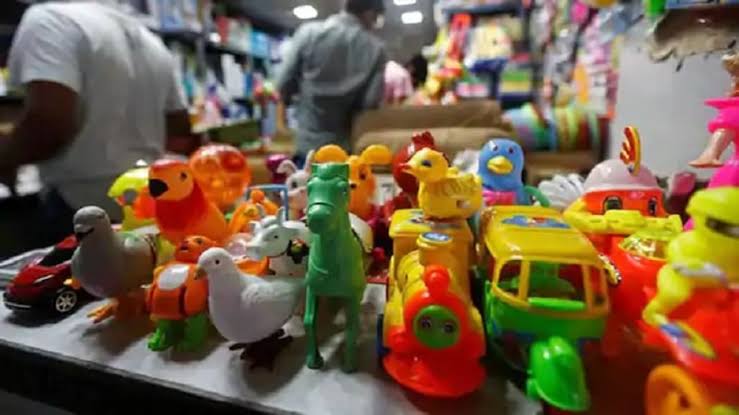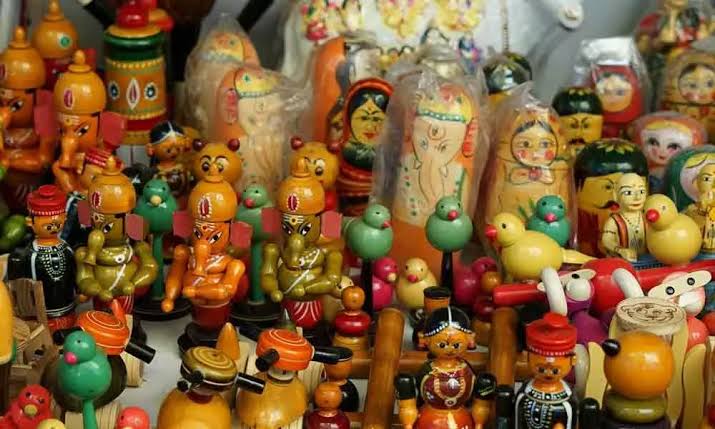Introduction: Bharat’s economy is deeply embedded in its rich culture. Temples, garments, jewelry, festivals, and food are integral parts of our heritage, also hold economic significance. Among these, our toys and dolls have a prominent place. Reflecting our Nation’s vast diversity, Bharat’s toy industry spans a wide range, from Channapatna of Karnataka to Kondapalli of Andhra Pradesh, from Thanjaur of Tamil Nadu to Varanasi of Uttar Pradesh. The list further extends further with Assam’s Asharikandi Terracotta toys, Bengal’s Natungram Toys and Rajasthan’s Kathputli (puppets).
Until the 1980s, Bharat was self-reliant in the toy industry. However, the liberalization of the economy in the 1990s led to an influx of imported toys, particularly from China, Netherlands, Hong Kong, Taiwan, and Sri Lanka. In 2020, PM Modi, known for his out-of-box ideas, launched the Atma Nirbhar Bharat (Self Reliant Bharat) initiative to counter the economic impact of the COVID pandemic. His vision extended to the toy industry, recognizing its untapped potential to drive economic growth.
Fillip to MSMEs: The Micro, Small & Medium Enterprises (MSME) sector plays a crucial role in economic growth by generating employment and fostering regional development, especially in rural and semi-urban areas. However, various challenges had hindered its full potential. Since 2020, the toy Industry as a significant part of MSME, has started to increase its contribution to economy. Spread across 4000 manufacturing units nationwide, Bharat’s Toy market was valued at USD 1.9 Billion in 2024 and is projected to grow a Compound Annual Growth Rate (CAGR) of 10.04% during 2025 to 2033. This growth is significantly contributing to the MSME sector’s overall expansion in GDP.
Contribution to Foreign Trade: Bharat currently ranks 27th in global toy exports. Between FY 2014-15 and FY 2022-23, the industry saw a remarkable growth, with imports declining by 52% and exports increasing by 239%. An improvement in the overall quality of the Toys is also witnessed in the domestic market. A Case Study on ‘Success Story of Made in India Toys’ by the Indian Institute of Management (IIM) Lucknow, commissioned by the Dept for Promotion of Industry and Internal Trade (DPIIT) highlighted key developments between 2014 to 2020.
- Doubling of manufacturing units
- Reduction in dependence on imported inputs (from 33% to 12%)
- Increase in gross sales value at a CAGR of 10%
- Rise in labor productivity.
To support domestic toy manufacturers, the Basic Customs Duty (BCD) was increased from 20% to 60% in Feb 2020 and further to 70% in Mar 2023. Additionally, sample testing of each import consignment was mandated to curb the influx of substandard toys.

Promoting Entrepreneurship: Catering Bharat’s vast population with formal jobs is a challenging task. And the best viable alternative is to encourage them with entrepreneurial skills. The toy Industry fosters entrepreneurship across our country in both rural & urban areas, supports business across states, promotes opportunities for socio-economically diverse groups including Other Backward Class (OBC), Schedule Caste (SC), Schedule Tribe (ST). Women also play a significant role, comprising 60% of toy factory workers while 90% of the industry operates in the unorganized sector. Spread across Delhi, Maharashtra, Karnataka, Tamil Nadu and small clusters across other states, toy industry provides a regular source of income to local artisans. The government’s focus on entrepreneurship in this sector is evident from its approval of 1,061 out of 1,097 licenses (97%) to the MSME sector, are for toy manufacturing units in 2023.
Encouraging Creativity: Children express creativity through their unique responses to their surroundings. Toys play a crucial role in their physiological, mental, and emotional development. Toy makers also face a unique challenge, to match with the children’s creativity while incorporating innovation into their products.
- The toy maker’s innovation starts from using attractive colors for the toys, to incorporating technology like augmented reality /virtual reality to amuse the children.
- Traditional toy-making utilizes wood, bamboo, cloth, metal sheets, wire, paper, cardboard, and other local materials.
- Many artisans use recycled materials, including newspapers, discarded cartons, metal scraps, boxes, and tins.
- Even parts of old machines and equipment are ingeniously repurposed.
The use of recycled materials enables artisans to manufacture and sell toys at highly affordable prices.
Cultural Connect: Toys and games are deeply intertwined with Bharat’s cultural heritage. They link our historic cities like Varanasi, Chitrakoot, Thanjaur and regions like Koppal of Karnataka, which was associated with the Shathavahanas, Gangas, Hoysalas, Chalukyas and Vijayanagara Dynasties, and later became the site of Bharat’s first Toy manufacturing cluster.
Bharat’s contribution to gaming history is exemplified by chess, which originated here. The Chaturanga Vallabhanathar Temple in Tiruvarur, Tamil Nadu, reflects this legacy. The term chaturanga (Sanskrit for ‘game of chess’) is linked to the temple, where, according to legend, Lord Shiva played chess with Goddess Parvati.
Through their designs and colors, local artisans showcase the richness of Bharat’s history, culture, occupations, and lifestyles.
National Action Plan for Toys (NAPT): PM Modi’s vision, articulated in his ‘Mann Ki Baat’ address in Aug 2020, aimed to establish Bharat as a global toy hub. This led to the formulation of the National Action Plan for Toys (NAPT), featuring 21 specific action points, coordinated by DPIIT, and implemented by various central ministries and departments.
- Establishing toy production clusters across the country
- Launching central government schemes to incentivize manufacturing and exports
- Strengthening R&D for innovative and educational toys
- Integrating toys with school education, especially in mathematics, history, and science
- Boosting consumer awareness through outreach campaigns
- Promoting innovation & design and upskilling artisans
- Encouraging working group through ‘Ek Bharat Shrestha Bharat’
- Meeting crowdsourcing procurement needs to boost demand.
- Utilizing analytics and digital marketing tools for targeted brand promotions
- Organizing hackathons and grand challenges to encourage design and innovation
- Building toy repository centers
- Promoting development of digital and online games
- Developing toy laboratories to test and monitor quality & safety standards.
- Organizing annual toy fairs and exhibitions across production hubs
- Focusing on the production of mechanical and electronic toys
- Observing an annual ‘Made in India Toy Day’ in schools.
- Strengthening awareness and production of indigenous toys such as puppets, wooden dolls, clay toys and tribal games
- Airing special programs on toys and games on public broadcast channels such as Doordarshan (DD) and All India Radio (AIR)
- Promoting toys are made with recycled and upcycled materials.
- Developing an e-commerce platform to provide a centralized direct marketing portal to handicraft artisans
- Building India’s first ‘Toy Museum’
Conclusion: PM Modi’s innovative initiative ‘Vocal for Local’ has unlocked the potential of Bharat’s toy industry, transforming it into a key economic driver. His thoughtful vision reminds us of Robert Frost’s famous lines from The Road Not Taken –
“I took the one less traveled by,
And that has made all the difference.”
Jai Hind!
(The views expressed are the author's own and do not necessarily reflect the position of the organisation)


